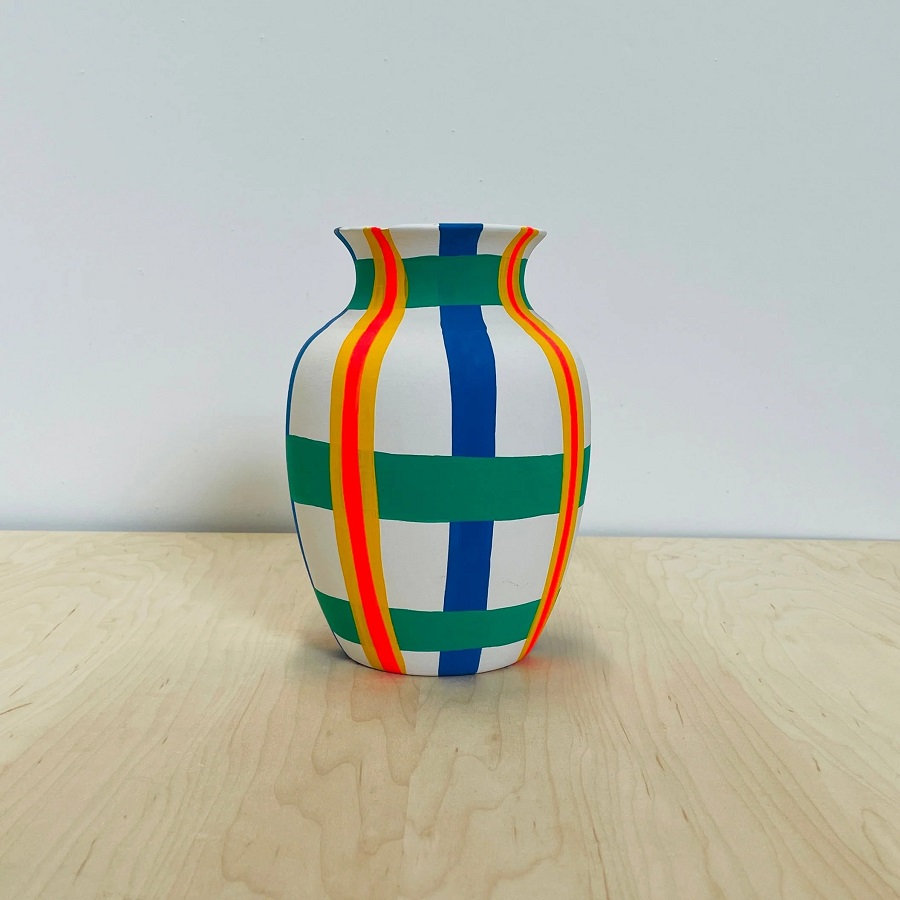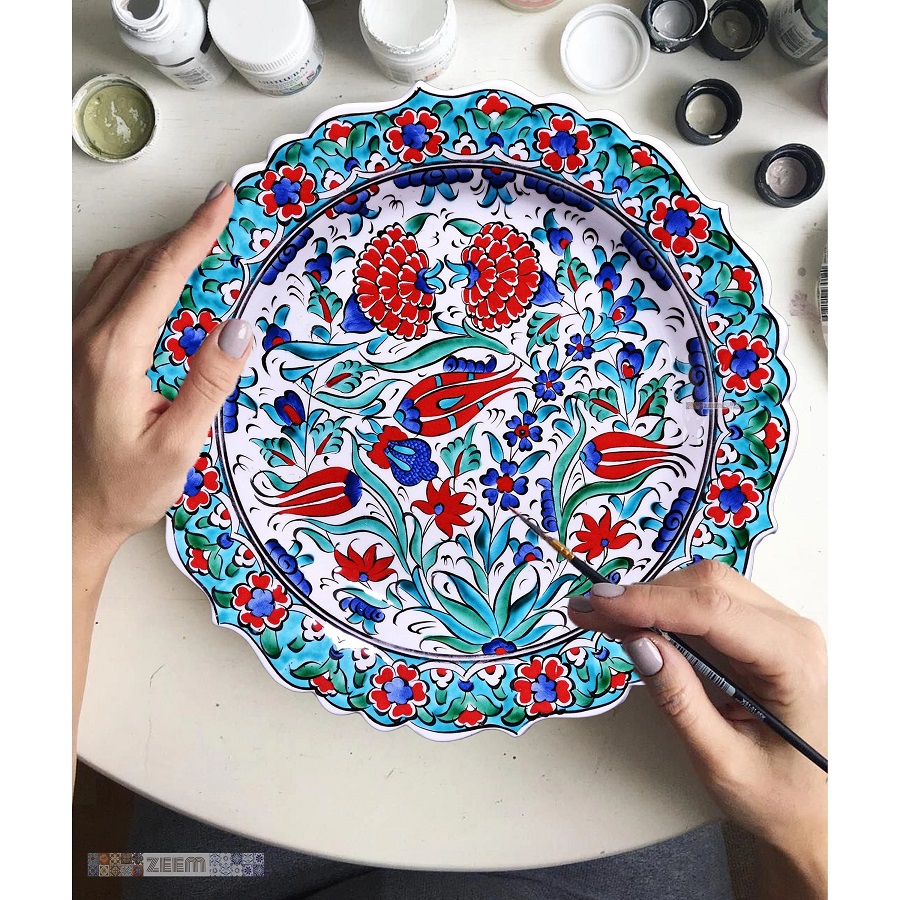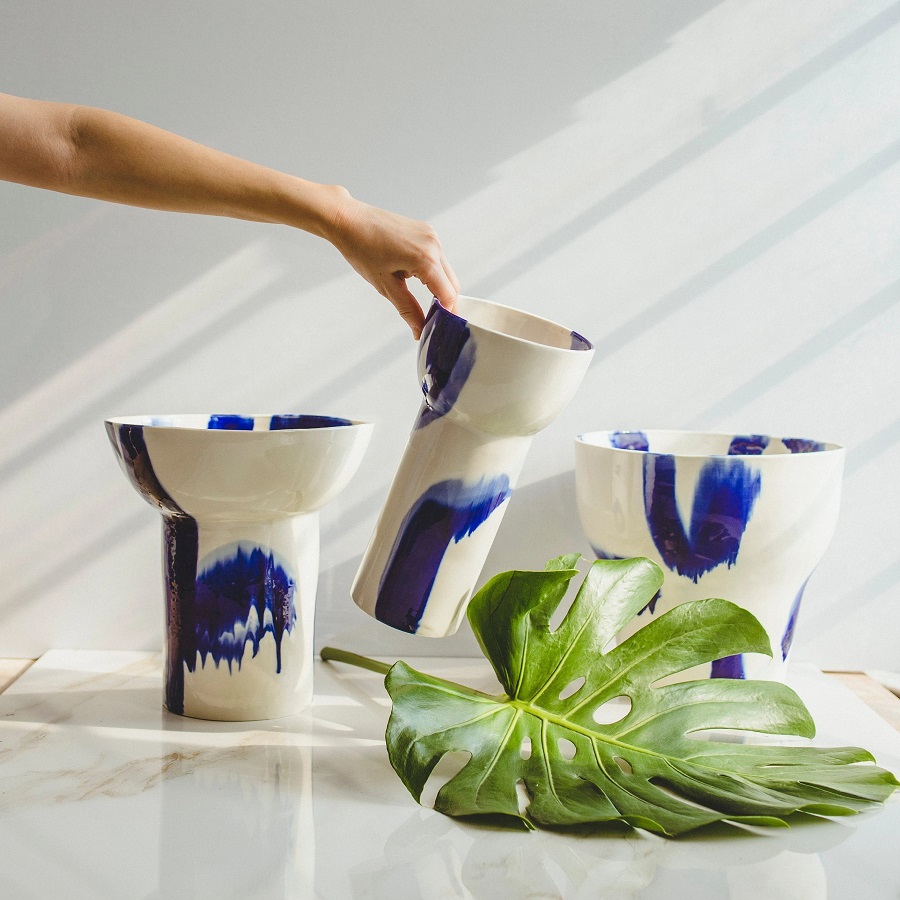Trending Painted Ceramic Styles in 2025
As trends evolve, the world of painted ceramics sees new styles in 2025. These styles reflect a mix of traditional methods and innovative designs. Here we’ll explore some of the most popular styles that ceramic artists and enthusiasts are embracing.
Minimalistic Elegance
Simplicity reigns in 2025, with clean lines and monochromatic color schemes. Artists favor a less-is-more approach. Pieces often feature a single bold color or subtle pastel shades. This style suits modern interiors and aligns with the minimalist lifestyle trend.
Rustic Charm
Rustic style painted ceramics come with a handcrafted look. Expect to see textures that mimic natural elements like stone and wood. Earthy tones and matte finishes are key to this homey style. These pieces create a warm, welcoming atmosphere in any space.
Bohemian Vibes
Vibrant colors and eclectic patterns define the Bohemian style. These painted ceramics showcase intricate designs and a mix of cultural influences. This style offers a bold statement and suits those who love a more adventurous and spirited decor.
Vintage Revival
Vintage motifs have made a comeback. Floral patterns, unique glazes, and retro shapes fill this niche. These painted ceramics pair well with both contemporary and traditional decor, giving a nod to the past while staying stylish.
Geometric Patterns
Sharp lines and shapes are the hallmarks of geometric ceramic styles. Bold and experimental, these patterns play with visual perception and add a dynamic flair to the space. From abstract to symmetrical, these designs are eye-catching and modern.
The scene for painted ceramics in 2025 is diverse and innovative. Each style offers a unique way to enhance living spaces and personal collections. No matter your taste, there’s a trending style that can suit your aesthetic and bring a special touch to your ceramics.

Color Palettes and Patterns for Ceramic Art
Ceramic art in 2025 thrives on a rich blend of color palettes and patterns. Artists and designers are choosing colors that not only complement the painted ceramic style trends but also resonate with personal expressions and contemporary aesthetics.
Bold and Bright Colors
Vivid hues are at the forefront, infusing energy into creations. Think citrus oranges, electric blues, and striking fuchsias dominating the scene. These impactful shades are perfect for statement pieces that capture attention.
Pastels and Neutrals
On the other end of the spectrum, soft pastels and warm neutrals provide a soothing counterbalance. Milky whites, gentle grays, and pale pinks offer a touch of serenity and sophistication to ceramic pieces.
Metallic Accents
Metallics have found their way onto ceramics, bringing a hint of glamour. Gold, silver, and bronze highlights are being used sparingly to accentuate features and add a luxurious feel.
Nature-Inspired Tones
Inspired by the outdoors, painters are turning to nature’s palette. Lush greens, sky blues, and earthy browns connect the artwork to the natural world, echoing the current eco-conscious movement.
Complex Patterns
Geometric patterns remain a popular choice for ceramic art, offering symmetry and precision. However, there’s also a surge in more complex, hand-drawn patterns, reflecting artists’ personal touch and narrative.
Cultural Motifs
Patterns featuring cultural iconography celebrate diversity and heritage. Whether inspired by traditional folk art or contemporary global designs, these patterns bridge history with modern-day artistry.
Choosing the right colors and patterns for painted ceramics can transform a simple piece into an evocative work of art. Discovering the perfect combination cultivates a sense of harmony between design, environment, and personal style.
Techniques for Painting on Ceramics
In the realm of painted ceramics, technique is as vital as style and color choice. In 2025, artists are merging traditional methods with modern twists to create captivating works. Let’s delve into some of the most effective techniques for painting on ceramics that are gaining popularity.
Sgraffito for Texture
Using the sgraffito technique, artists scratch away paint to reveal the clay beneath. This creates unique textures. Artists layer contrasting colors before etching to enhance the visual effect.
Watercolor Effects
Watered-down paints let artists achieve a watercolor look on ceramics. They blend and bleed colors to mimic the fluidity of traditional watercolor paintings.
Underglazing for Depth
Underglazing involves applying paint to the bisqueware before glazing and firing. This results in a rich color that has depth and durability, ideal for dinnerware and decorative pieces.
Stenciling for Precision
Stencils guide paint application, providing clean lines and shapes. Perfect for geometric patterns, stenciling ensures consistency and precision across multiple pieces.
Brushwork Techniques
From delicate line work to bold strokes, brushwork defines the style. Artists play with brush types and sizes to create the desired pattern and texture.
Airbrushing for Gradients
Using an airbrush, painters can create smooth gradients and subtle color transitions. It’s a method that lends a contemporary feel to classic forms.
Each technique can significantly affect the final appearance of painted ceramics. Artists choose their methods based on the effect they want to achieve and their personal expression. By mastering these techniques, ceramic artists in 2025 are pushing the boundaries of this art form.

Must-Have Tools for Ceramic Painting
While style, color, and technique are essential, the right tools are just as important. Here are must-have tools for any ceramic painting task:
Brushes of Various Sizes
Brushes are the painter’s primary tool. For fine details, use small, pointed brushes. Larger, flat brushes work well for broad strokes.
Palette Knives
Palette knives allow artists to mix paints and apply them in unique ways. They are great for creating texture.
Sponges
Sponges dab or wipe paint on ceramics, offering a variety of textures and patterns.
Water Basins
Clean water is vital for rinsing brushes and thinning paints. Keep several basins handy.
Palettes
Palettes hold your paints while you work. Choose one with multiple wells for different colors.
Stencils and Tapes
Use stencils for precise designs. Tapes help ensure straight lines and protect areas from paint.
Airbrushes
For even coverage and subtle shading, an airbrush is the perfect tool.
Cleaning Tools
Have brushes and sponges specifically for cleaning up spills and excess paint.
These tools help you apply the techniques and styles that define your painted ceramics. With them, you can develop, refine, and perfect your ceramic art in 2025.
Best Types of Paints for Ceramics
Choosing the right type of paint is crucial for the success of your painted ceramics project. In 2025, there are several options that consistently deliver quality results, allowing the colors and patterns to pop and last long after the kiln has cooled down.
Acrylic Paints
Acrylics are a favorite among ceramic artists for their quick drying time and vibrant color range. They’re excellent for projects that don’t require firing, such as decorative pieces. Seal them with a clear varnish to protect from wear.
Underglazes
Underglazes are essential for painted ceramics fired in a kiln. They adhere well to bisqueware and withstand high temperatures. They maintain color depth after firing, making them a reliable choice for functional ware.
Glaze Paints
Glaze paints fuse to the ceramic during the firing process, creating a glossy, protective finish. They’re ideal for dinnerware as they are food-safe once fired.
Oil-based Paints
Oil-based paints have a rich pigment and smooth application. They take longer to dry but offer a durable and high-quality finish for ceramics that aren’t intended for everyday use.
Enamel Paints
Enamel paints provide a glossy sheen and are often used for intricate work and fine details. They require a steady hand but the results are impressive with their lasting finish.
Each paint type has different setting requirements and finishes, so select the right one based on your project’s needs. For those at the forefront of ceramic artistry in 2025, experimenting with different paints opens up an array of creative possibilities.

Creative Ideas for Painted Ceramic Projects
When it comes to unleashing creativity on painted ceramics, the possibilities are as vast as your imagination. Here are some creative project ideas that harness the trends and techniques of 2025 to inspire your next masterpiece:
Personalized Mugs
Everyone loves a mug that speaks to their personality. Use bold, bright colors or intricate patterns to create a one-of-a-kind mug. Add names or heartfelt quotes for a personal touch.
Decorative Plates
Transform plain plates into wall art with vintage motifs or geometric patterns. Hang a series of plates with a cohesive theme for an impactful display.
Plant Pots
Bohemian vibes and nature-inspired tones work beautifully on plant pots. Experiment with textures, using the sgraffito technique for added depth.
Jewelry Holders
Craft small dishes or bowls with metallic accents to hold jewelry. They’re not only functional but also add a touch of luxury to any vanity.
Tile Coasters
Create sets of coasters using watercolor effects or cultural motifs. They’re practical, make great gifts, and are a canvas for experimentation.
Vases
Combine various painting techniques to design standout vases. Think airbrushed gradients matched with detailed brushwork for an eye-catching piece.
Candle Holders
Use pastels and neutrals to paint serene patterns on candle holders. The soft glow of the candle will enhance the soothing design.
Developing painted ceramic projects is about mixing personal style with current trends. Each piece can reflect individuality while embracing new and traditional methods. With these ideas, you’re set to craft painted ceramics that are both beautiful and expressive.
Tips on Preserving Your Painted Ceramics
To keep your painted ceramics looking new for years, follow these tips. Proper care will preserve the vibrant colors and intricate designs of your creations.
Handle with Care
Treat your ceramics gently to prevent chips and cracks. Always lift them from the base rather than the rim or handle.
Clean Correctly
Wipe your ceramics with a soft, damp cloth. Avoid harsh cleaners or abrasive pads that can damage the paint.
Avoid Extreme Temperatures
Sudden changes in temperature can cause ceramics to crack. Do not use them in ovens or freezers.
Display Safely
When displaying, choose a stable location out of direct sunlight. UV rays can fade the paint over time.
Use Protective Displays
Consider using a cabinet with glass doors or shelves away from high traffic. It reduces the risk of accidents.
Keep Dry
Ensure ceramics are completely dry before storing. Any moisture can lead to mold or mildew.
Store Carefully
Wrap your ceramics in soft materials when stored. This protects them from dust and other potential damage.
By following these simple tips, your painted ceramics can remain a timeless treasure in your home.
Where to Find Inspiration for Ceramic Painting
Finding inspiration for painted ceramics can sometimes be as challenging as the painting process itself. Here are several ways to spark your creativity and start your next project with a burst of inspiration.
Nature’s Palette
Step outside and observe the colors and textures around you. Nature offers an endless array of designs, from the delicate veins of leaves to the bold colors of flowers.
Historical Artifacts
Visit a museum or look at online archives. Ancient pottery and historic artworks can provide insights into timeless techniques and motifs.
Modern Design Trends
Follow design blogs, magazines, and social media accounts focused on interior design trends. They can introduce you to new color combinations and patterns.
Personal Experiences
Draw from your own life and experiences. A memorable trip, an emotional event, or a beloved hobby can all translate into beautiful ceramic art.
Community Workshops
Participate in ceramic workshops or classes. Interacting with other artists can lead to new ideas and collaborations.
Cultural Patterns
Explore patterns and design elements from different cultures. This can lead to a rich and diverse source of inspiration that is often untapped.
Remember, the key to finding inspiration for your painted ceramics is to stay curious and be open to the world around you. Every experience and image you encounter can fuel your next great design.